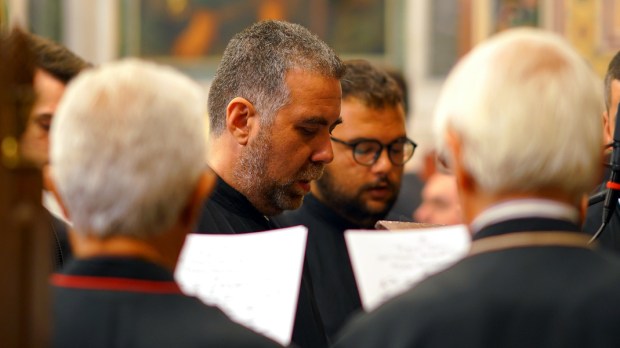The United Nations has recognized Byzantine chant as a treasure of intangible cultural heritage.
UNESCO, the U.N.’s culture department, placed the 2000-year-old liturgical musical tradition on a list of intangible cultural heritage in December, along with traditions from around the world such as dances in honor of the Christ Child, Holy Week processions, and a forgiveness ceremony inspired by a pope.
Though Cyprus and Greece were singled out for the recognition, Byzantine chant exists in numerous countries. The word Byzantine refers to that tradition evolving from the Byzantine Empire—centered on Constantinople, the seat of the Roman Empire after the decline of Rome itself. The Church of Constantinople became the mother Church to many others, including those in Slavic lands.
Byzantine Divine Liturgies celebrated by Eastern Orthodox and Eastern Catholic Churches are almost entirely sung.
“Byzantine music is an art transmitted orally. The student listens to the teacher, and then he transmits to others what he learned. Then the student transmits it to his own students and so on,” said Fr. Nikolaos Lympouridis, who teaches Byzantine chant at the School of Byzantine and Traditional Music of the Holy Metropolis of Lemesos, in Limassol, Cyprus. “It is the means through which we express our worship to God and our relation to our fellow human beings.”
“What we are trying to preserve is this old student-teacher relationship, which resembles the loving relationship between brothers or father and so on,” said Evangelos Georgiou, director of the Cypriot Melodists Byzantine Choir.
“As a living art that has existed for more than 2000 years, the Byzantine chant is a significant cultural tradition and comprehensive music system forming part of the common musical traditions that developed in the Byzantine Empire,” UNESCO said. “Highlighting and musically enhancing the liturgical texts of the Greek Orthodox Church, it is inextricably linked with spiritual life and religious worship. This vocal art is mainly focused on rendering the ecclesiastical text; arguably, the chant exists because of the word (logos), since every aspect of the tradition serves to spread the sacred message. Passed on aurally across the generations, its main characteristics have remained over the centuries: it is exclusively vocal music; it is essentially monophonic; the chants are codified into an eight-mode or eight-tone system; and the chant employs different styles of rhythm to accentuate the desired syllables of specific words.”
UNESCO noted that in addition to its transmission in church, Byzantine chant is flourishing due to the dedication of experts and non-experts alike, including musicians, choir members, composers, musicologists and scholars who contribute to its study, performance and dissemination.
Here is a collection of Byzantine chants on YouTube:

